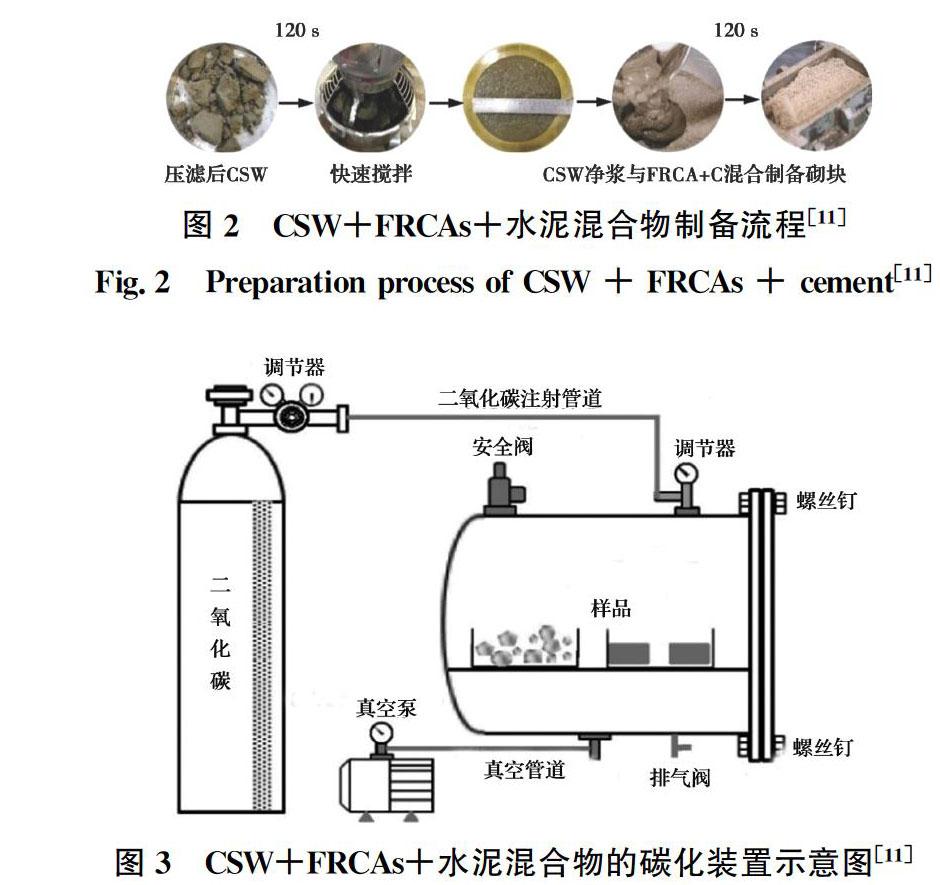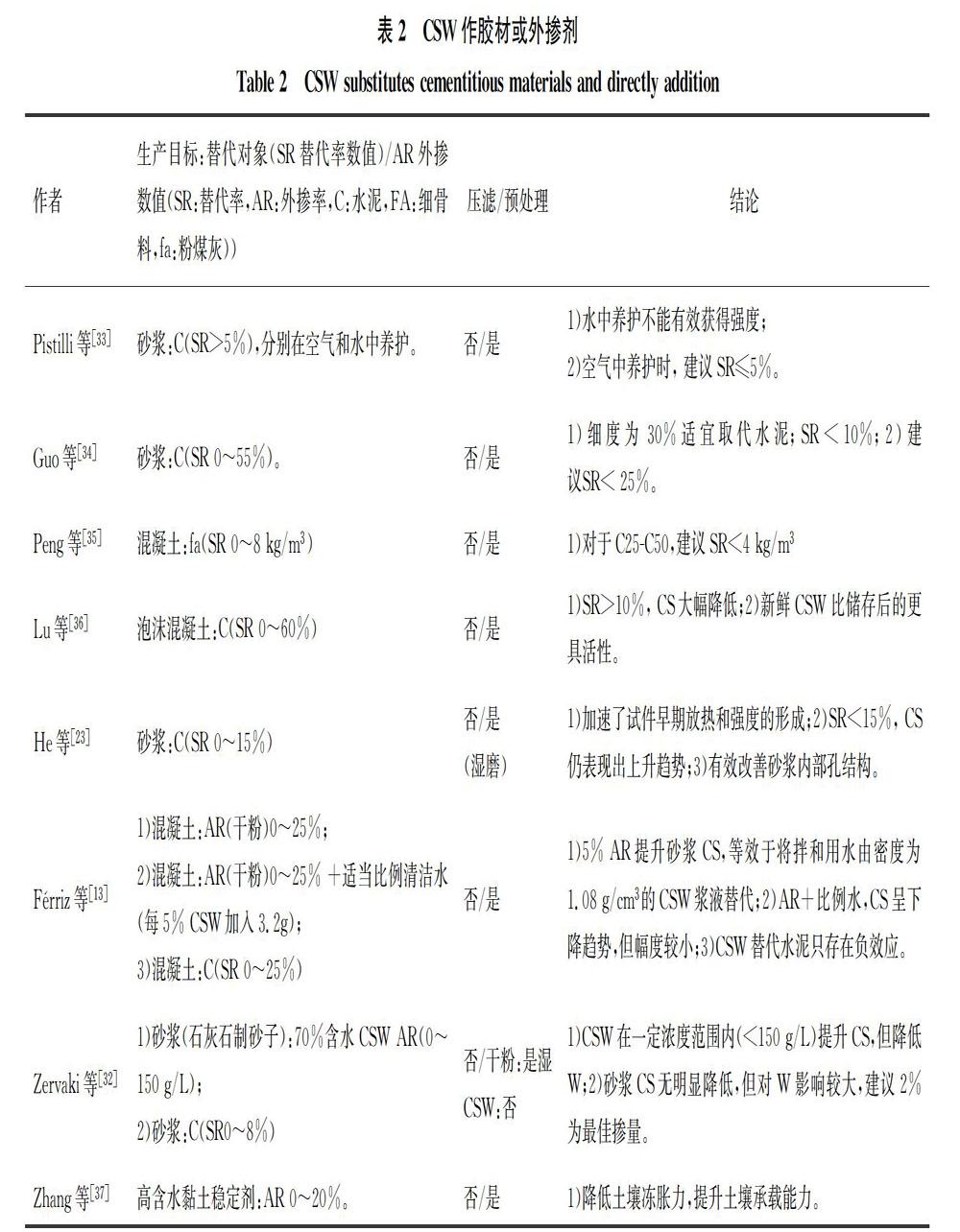多源低活性混凝土廢漿再生利用的研究進(jìn)展
高英力 段開瑞 何倍 曾維 徐藝珅 卜濤 龍國(guó)鑫



摘 要:混凝土廢漿(Concrete Slurry Waste, CSW)是混凝土攪拌站中特有的富含硅酸鹽類礦物的未硬化廢棄物,因成分復(fù)雜、高含水、毒害性、腐蝕性等特點(diǎn),其再生利用一直受到極大的限制。綜述當(dāng)前對(duì)CSW的大宗再生利用的研究成果,包括:再生為水泥混凝土制品用粗、細(xì)骨料、填料、膠材(濕法研磨技術(shù))和外摻劑,作為水泥熟料生產(chǎn)用原料,基于碳化技術(shù)和冷粘結(jié)造粒技術(shù)制備新型砼制品和輕型骨料以及與單、雙組分堿激發(fā)膠材的復(fù)合再生應(yīng)用。指出CSW未來高效再生利用的主要研究方向:CSW低能耗預(yù)處理技術(shù)與活性激發(fā)技術(shù),碳化技術(shù),重金屬的長(zhǎng)期浸出行為和耐久性研究。
關(guān)鍵詞:混凝土廢漿;硅酸鹽;再生利用;廢棄物
Abstract: Concrete slurry waste, CSW is a unique unhardened construction waste which is rich in silicate minerals generated from concrete ready-mixing plant. However, its recycling has always been greatly restricted owing to its complex composition, high water to solidratio, hazardous and corrosion. The large-scale recycling methods of CSW are comprehensively reported and commented in this paper, including recycling as coarse and fine aggregates, fillers, cementitious materials (wet grinding technology), additions in concrete and raw materials for cement clinker production; preparation of new type of concrete products and lightweight aggregates by carbonation and cold bonded pelletizing technique; the development in "one or two"part alkali-activated materials (AAMs).The promising research directions of CSW in the future are pointed out as follows: 1.Pre-treatment regeneration technologyand active excitation technology with low energy consumption;2. Carbonation technology; 3. Long term leaching behavior of heavy metals and durability.
Keywords: concrete slurry waste; silicate; recycling; waste
混凝土作為全球第二大人造消耗材料,年產(chǎn)量超過300億t,其生產(chǎn)帶來的大量CO2排放與廢棄物的堆積一直是世界公眾所擔(dān)憂的問題[1-2]。目前,混凝土廢棄物再生熱點(diǎn)集中于已硬化的“建筑與拆除廢棄物(Construction and Demolition Waste,CDW)”[3-4]。研究表明,CDW非常適合作為再生骨料應(yīng)用于新建建筑物中[5-7],包括道路結(jié)構(gòu)中瀝青混合料用骨料、碎石隔離層以及溝槽的回填等[8-10]。然而,對(duì)于混凝土攪拌站中的高含水未硬化廢棄物,其再生利用進(jìn)展卻相對(duì)較緩慢[11-12]。
在實(shí)際生產(chǎn)中,混凝土攪拌站得到的廢棄物主要有4種:返廠的仍具有工作性的混凝土、再生骨料、再生水和混凝土廢漿CSW(Concrete Slurry Waste)[13]。其中,部分返廠的仍具有工作性的混凝土,會(huì)被降級(jí)用于制備特殊的、具有標(biāo)準(zhǔn)尺寸的水泥混凝土板或用作回填墊層的充填材料[14];再生水可用于清洗攪拌車、堆料場(chǎng)以及拌和新拌混凝土[15-16];而分離得到的再生骨料則和CDW一樣,可被收集并應(yīng)用于新建建造物中[17-18];只有CSW在短暫的存放期后,會(huì)被集中運(yùn)往公共場(chǎng)地進(jìn)行堆埋。相關(guān)數(shù)據(jù)顯示,亞洲國(guó)家的混凝土攪拌站平均每生產(chǎn)1 t混凝土,就會(huì)產(chǎn)生15~20 kg CSW,僅中國(guó)香港一地,每年的CSW產(chǎn)量就超過12萬(wàn)t[19-20]。筆者針對(duì)CSW的再生利用研究進(jìn)行全面綜述,并指出其未來高效再生利用的發(fā)展方向。
1 CSW的產(chǎn)生過程和理化特性
CSW的產(chǎn)生過程如圖1所示,返廠混凝土經(jīng)過鼓式再生設(shè)備或轉(zhuǎn)篩式再生設(shè)備與壓力水的沖洗,被分為再生骨料和廢水與砂漿的混合物,經(jīng)過標(biāo)準(zhǔn)沉淀池過濾后,得到CSW(pH=10.5~12.5)[18]。CSW主要由細(xì)骨料(少部分粗骨料)、水泥水化產(chǎn)物(包括碳化產(chǎn)物)、廢水和少部分礦物摻合料(如粉煤灰)組成[21]。由表1中XRF的測(cè)試結(jié)果可以看出,CSW的化學(xué)組成和水泥十分相似,但CSW中的CaO含量明顯少于水泥,而Al2O3含量高于水泥,這意味著CSW中含有較多硅鋁酸鹽礦物。
2 基于水泥混凝土體系的再生應(yīng)用研究
2.1 取代骨料和填料
Audo[24]的研究結(jié)果表明,CSW中的砷(0.54 mg/kg)和鉻(0.51~0.64 mg/kg)等重金屬元素的浸出濃度時(shí)常會(huì)超過臨界標(biāo)準(zhǔn)(根據(jù)歐洲官方標(biāo)準(zhǔn),CSW中砷和鉻的浸出濃度應(yīng)小于0.50 mg/kg)。但將CSW應(yīng)用于水泥混凝土中,可以有效固封住重金屬元素,從而防止CSW規(guī)模化處置帶來的重金屬污染。由于長(zhǎng)時(shí)間在沉淀池中存儲(chǔ),CSW內(nèi)部所含有的仍具有水化活性的顆粒較少,因此,將其用于替代水泥混凝土制品中的粗、細(xì)骨料和填料十分合適[25–28]。當(dāng)CSW用于替代骨料時(shí),首先需經(jīng)過干燥、研磨、破碎和過篩等預(yù)處理,部分?jǐn)嚢枵具€需經(jīng)過壓濾脫水。其中,CSW壓濾脫水后形成的泥餅(含水率75%~113%)可以在幾天之內(nèi)迅速硬化,而后被破碎得到再生骨料[14]。目前,CSW替代骨料存在預(yù)處理能耗、人工機(jī)械成本較高,骨料品質(zhì)較低等一系列問題,多被建議用于非結(jié)構(gòu)性混凝土制品[21, 29-31]。
2.2 作為膠材和外摻劑
與替代骨料相比,在不過多影響流動(dòng)度和試件強(qiáng)度的前提下,CSW作為膠凝材料的取代率僅維持在個(gè)位數(shù)水平。表2總結(jié)了CSW作為膠凝材料的部分研究成果。值得注意的是,濕法研磨技術(shù)的使用較大幅度地提升了CSW替代水泥的比例(15%),相比于傳統(tǒng)的預(yù)處理技術(shù),該技術(shù)對(duì)CSW的活性激發(fā)效率更高且能耗和成本更低[23]。除常規(guī)取代骨料和膠材外,部分研究人員還將CSW視為一種“外摻劑”,以干粉或原狀高含水狀態(tài)的形式小劑量摻入到水泥混凝土制品中,用以提升試件的抗壓強(qiáng)度[13,32]。這種在“零預(yù)處理”前提下,將含水廢漿與拌和用水混合并直接摻入制品的再生方式值得借鑒,但由于其可摻濃度較低(<150 g/L),該再生方式下CSW的利用效率是一個(gè)亟待解決的問題。
2.3 碳化與冷粘結(jié)造粒技術(shù)
碳化技術(shù)可實(shí)現(xiàn)“固廢”和“氣廢”的耦合利用,是一項(xiàng)區(qū)別于傳統(tǒng)CSW再生方式的新技術(shù)[38]。Xuan等[22]研究了新鮮CSW對(duì)CO2的固存潛力,并將CSW與再生混凝土細(xì)集料(FRCAs)進(jìn)行復(fù)配。結(jié)果表明,CSW、FRCAs及其混合物在礦物碳化作用下可以在數(shù)小時(shí)內(nèi)快速獲得強(qiáng)度并伴隨著較低的干縮率。在此研究基礎(chǔ)上,研究人員利用3 h加速碳化的方法制備了一種新型混凝土制品[11]:以質(zhì)量比CSW∶FRCA∶水泥=1∶4∶0.15,用30 MPa
的靜壓力預(yù)壓實(shí),24 h后脫模,放進(jìn)碳化設(shè)備加速碳化。試件制備流程如圖2、圖3所示。結(jié)果表明,在3 h加速碳化作用下,CSW混合物可獲得28 d強(qiáng)度的81%,但強(qiáng)度受CSW的水固比影響較大。Hossain等[39]利用生命周期評(píng)價(jià)技術(shù)(LCA)評(píng)價(jià)了碳化技術(shù)對(duì)于CSW的可持續(xù)發(fā)展性。結(jié)果表明,碳化CSW生產(chǎn)砌塊相比于普通原材料可實(shí)現(xiàn)能源減排59%、溫室氣體減排66%。此外,運(yùn)用冷粘結(jié)造粒技術(shù),將新鮮CSW與城市焚燒底灰復(fù)合,并結(jié)合CO2養(yǎng)護(hù)技術(shù),可制備出輕型骨料。該技術(shù)不僅能實(shí)現(xiàn)CSW、
市政廢棄物與氣體廢棄物的綜合利用,還為水泥混凝土制品提供了額外的骨料來源,大大減輕了由于天然石料開采造成的資源緊缺壓力[40-42]。
2.4 生產(chǎn)水泥熟料
Schoon等[43-44]評(píng)價(jià)了CSW是否有作為水泥熟料生產(chǎn)原料的可能性。結(jié)果表明,由于從不同攪拌站取出的CSW化學(xué)成分差異過大,導(dǎo)致了CSW并不能成為穩(wěn)定可靠的水泥熟料生產(chǎn)原料,且CSW的細(xì)顆粒除能提升原料在燒結(jié)時(shí)的可燃性外,并不能夠有效提升熟料中的有效化學(xué)成分。并指出了利用再生材料和工業(yè)副產(chǎn)品生產(chǎn)水泥原料時(shí)需要注意的要點(diǎn)。
3 基于單、雙組分堿激發(fā)膠材(AAMs)的再生應(yīng)用研究 除水泥混凝土體系外,以工業(yè)廢棄物為原料的AAMs膠凝體系在CSW的再生利用中卻極少受到關(guān)注。Yang等[45]曾利用CSW與偏高嶺土、硅灰混合,以氫氧化鈉和硅酸鈉作為堿激發(fā)劑,制備了傳統(tǒng)的“雙組分”AAMs。試驗(yàn)結(jié)果表明,CSW作為激發(fā)原料,自身的堿激發(fā)活性較低,基體強(qiáng)度主要由偏高嶺土等高活性硅鋁質(zhì)材料提供。考慮到雙組分堿激發(fā)膠凝材料需預(yù)先配置具有腐蝕性和一定黏度的堿激發(fā)溶液,且CSW也具有較高的堿性,實(shí)際制備時(shí),不論CSW以干粉或含水狀態(tài)摻加,其實(shí)際可操作性、制備流程的便利性和安全性均有待考量,如圖4所示[46-48]。為簡(jiǎn)化CSW與AAMs復(fù)合材料的制備流程,避免操作性和安全性問題,提出單組分AAMs與原狀高含水CSW復(fù)合材料的制備思路。單組分AAMs,即,“不需提前配制堿性溶液,直接將堿顆粒與硅鋁質(zhì)廢棄物混合,通過加水觸發(fā)化學(xué)反應(yīng)”[46, 49-51]。如圖5所示,CSW中的廢水可用于提供流動(dòng)性和液體反應(yīng)環(huán)境,而其內(nèi)部含有的固體廢棄物顆粒可被視作單組分AAMs中的骨料或填料。
4 結(jié)論與展望
1)CSW作骨料時(shí),應(yīng)注重提升骨料的品質(zhì),采取各種措施降低骨料孔隙率、移除或增強(qiáng)粘附在骨料上的老砂漿。
2)CSW作膠材的取代率較低,應(yīng)結(jié)合包括濕法研磨等低能耗活性激發(fā)技術(shù)和分離技術(shù)(分離CSW中的惰性SiO2),從而提升CSW作為膠材的反應(yīng)活性。
3)碳化技術(shù)在CSW的再生利用中極具前景,但所生產(chǎn)制品的環(huán)境穩(wěn)定性和重金屬離子的長(zhǎng)期浸出行為還有待進(jìn)一步研究。
4)應(yīng)注重實(shí)現(xiàn)CSW與各種硅鋁質(zhì)廢棄物的綜合利用,積極開展CSW在堿激發(fā)膠凝材料體系中的再生利用研究。
參考文獻(xiàn):
[1] PETEK GURSEL A, MASANET E, HORVATH A, et al. Life-cycle inventory analysis of concrete production: a critical review [J]. Cement and Concrete Composites, 2014, 51: 38-48.
[2] KAZAZ A, ULUBEYLI S. Current methods for the utilization of the fresh concrete waste returned to batching plants [J]. Procedia Engineering, 2016, 161: 42-46.
[3] SHI C J, LI Y K, ZHANG J K, et al. Performance enhancement of recycled concrete aggregate - A review [J]. Journal of Cleaner Production, 2016, 112: 466-472.
[4] PARANHOS R S, CAZACLIU B G, SAMPAIO C H, et al. A sorting method to value recycled concrete [J]. Journal of Cleaner Production, 2016, 112: 2249-2258.
[5] 鮑玖文, 李樹國(guó), 張鵬, 等. 軸壓重復(fù)荷載作用后再生混凝土毛細(xì)吸水性能[J]. 建筑材料學(xué)報(bào), 2021, 24(1): 71-76.
BAO J W, LI S G, ZHANG P, et al. Water absorption of recycled aggregate concrete after repeated axialcompressive loading [J]. Journal of Building Materials, 2021, 24(1): 71-76. (in Chinese)
[6] 鮑玖文,李樹國(guó), 張鵬,等. 再生粗骨料硅烷浸漬處理對(duì)混凝土介質(zhì)傳輸性能的影響[J]. 復(fù)合材料學(xué)報(bào), 2020, 37(10): 2602-26.
BAO J W, LI S G, ZHANG P, et al. Effect of recycled coarse aggregate after strengthening by silane impregnation on mass transport of concrete [J]. Acta Materiae Compositae Sinica, 2020, 37(10): 2602-26. (in Chinese)
[7] 王繹景, 李珠, 秦淵, 等. 再生骨料替代率對(duì)混凝土抗壓強(qiáng)度影響的研究[J]. 混凝土, 2018(12): 27-30, 33.
WANG Y J, LI Z, QIN Y, et al. Effect of replacement rate of recycled coarseaggretrate on compressive strength of concrete [J]. Concrete, 2018(12): 27-30, 33.(in Chinese)
[8] GMEZ-MEIJIDE B, PREZ I, PASANDN A R. Recycled construction and demolition waste in cold asphalt mixtures: Evolutionary properties [J]. Journal of Cleaner Production, 2016, 112: 588-598.
[9] DEL REY I, AYUSO J, GALVIN A P, et al. Feasibility of using unbound mixed recycled aggregates from CDW over expansive clay subgrade in unpaved rural roads [J]. Materials, 2016, 9(11): 931.
[10] OSSA A, GARCA J L, BOTERO E. Use of recycled construction and demolition waste (CDW) aggregates: A sustainable alternative for the pavement construction industry [J]. Journal of Cleaner Production, 2016, 135: 379-386.
[11] XUAN D X, ZHAN B J, POON C S, et al. Innovative reuse of concrete slurry waste from ready-mixed concrete plants in construction products [J]. Journal of Hazardous Materials, 2016, 312: 65-72.
[12] SEALEY B J, PHILLIPS P S, HILL G J. Waste management issues for the UK ready-mixed concrete industry [J]. Resources, Conservation and Recycling, 2001, 32(3/4): 321-331.
[13] FRRIZ PAP J A. Recycling of fresh concrete exceeding and wash water in concrete mixing plants [J]. Materiales De Construcción, 2014, 64(313): e004.
[14] XUAN D X, POON C S, ZHENG W. Management and sustainable utilization of processing wastes from ready-mixed concrete plants in construction: A review [J]. Resources, Conservation and Recycling, 2018, 136: 238-247.
[15] ASADOLLAHFARDI G, ASADI M, JAFARI H, et al. Experimental and statistical studies of using wash water from ready-mix concrete trucks and a batching plant in the production of fresh concrete [J]. Construction and Building Materials, 2015, 98: 305-314.
[16] SU N, MIAO B Q, LIU F S. Effect of wash water and underground water on properties of concrete [J]. Cement and Concrete Research, 2002, 32(5): 777-782.
[17] ARUNVIVEK G K, MAHESWARAN G, SENTHIL KUMAR S. Eco-friendly solution to mitigate the toxic effects of hazardous construction industry waste by reusing in concrete for pollution control [J]. Nature Environment and Pollution Technology, 2015, 14(4): 963-966.
[18] VIEIRA L D B P, FIGUEIREDO A D D. Evaluation of concrete recycling system efficiency for ready-mix concrete plants [J]. Waste Management, 2016, 56: 337-351.
[19] IIZUKA A, SAKAI Y K, YAMASAKI A, et al. Bench-scale operation of a concrete sludge recycling plant [J]. Industrial & Engineering Chemistry Research, 2012, 51(17): 6099-6104.
[20] TAM V W Y. Economic comparison of concrete recycling: A case study approach [J]. Resources, Conservation and Recycling, 2008, 52(5): 821-828.
[21] RUGHOOPUTH R, RANA J O, JOORAWON K. Possibility of using fresh concrete waste in concrete for non structural civil engineering works as a waste management strategy [J]. KSCE Journal of Civil Engineering, 2017, 21(1): 94-99.
[22] XUAN D X, ZHAN B J, POON C S, et al. Carbon dioxide sequestration of concrete slurry waste and its valorisation in construction products [J]. Construction and Building Materials, 2016, 113: 664-672.
[23] HE X Y, ZHENG Z Q, MA M Y, et al. New treatment technology: The use of wet-milling concrete slurry waste to substitute cement [J]. Journal of Cleaner Production, 2020, 242: 118347.
[24] AUDO M, MAHIEUX P Y, TURCRY P, et al. Characterization of ready-mixed concrete plants sludge and incorporation into mortars: Origin of pollutants, environmental characterization and impacts on mortars characteristics [J]. Journal of Cleaner Production, 2018, 183: 153-161.
[25] WANG R X, ZHANG Y X. Recycling fresh concrete waste: A review [J]. Structural Concrete, 2018, 19(6)1939-1955
[26] CORREIA S L, SOUZA F L, DIENSTMANN G, et al. Assessment of the recycling potential of fresh concrete waste using a factorial design of experiments [J]. Waste Management, 2009, 29(11): 2886-2891.
[27] MOON H Y, CHOI Y W, SHIN H C. A study on thepractical recycling of ready mixed concrete sludge water to concrete [J]. Geosystem Engineering, 2001, 4(3): 89-93.
[28] AUDO M, MAHIEUX P Y, TURCRY P. Utilization of sludge from ready-mixed concrete plants as a substitute for limestone fillers [J]. Construction and Building Materials, 2016, 112: 790-799.
[29] KOU S C, ZHAN B J, POON C S. Properties of partition wall blocks prepared with fresh concrete wastes [J]. Construction and Building Materials, 2012, 36: 566-571.
[30] KOU S C, ZHAN B J, POON C S. Feasibility study of using recycled fresh concrete waste as coarse aggregates in concrete [J]. Construction and Building Materials, 2012, 28(1): 549-556.
[31] KUSUI T, AMANO N N Y. Study on recycle of concrete sludge produced at concrete mills in Toyama Prefecture [J].Journal of Ecotechnology Research, 2014, 17: 39-43.
[32] ZERVAKI M, LEPTOKARIDIS C, TSIMAS S. Reuse of by-products from ready-mixed concrete plants for the production of cement mortars [J]. Journal of Sustainable Development of Energy, Water and Environment Systems, 2013, 1(2): 152-162.
[33] PISTILLI M F, PETERSON C F, SHAH S P. Properties and possible recycling of solid waste from ready-mix concrete [J]. Cement and Concrete Research, 1975, 5(3): 249-259.
[34] 郭元強(qiáng), 張興富, 陳展華, 等. 初探混凝土廢漿粉對(duì)水泥膠砂性能的影響[J]. 商品混凝土, 2019(4): 34-38.
GUO Y Q, ZHANG X F, CHEN Z H, et al. The effect of concrete waste slurry powder on the performance of cement mortar [J]. Ready-Mixed Concrete, 2019(4): 34-38.(in Chinese)
[35] 彭孟啟, 張橋, 孫國(guó)彬. 廢漿固渣引入量對(duì)混凝土性能的影響[J]. 中國(guó)建材科技, 2018, 27(4): 54-57.
PENG M Q, ZHANG Q, SUN G B. Effect of solid waste introduction on concrete performance [J]. China Building Materials Science & Technology, 2018, 27(4): 54-57.(in Chinese)
[36] 盧佳林, 陳景, 甘戈金. 混凝土攪拌站廢漿制備泡沫混凝土技術(shù)研究[J]. 商品混凝土, 2017(Sup1): 80-82.
LU J L, CHEN J, GAN G J.Study on foamed concrete prepared by waste slurry from concrete mixing plant [J]. Ready-Mixed Concrete, 2017(Sup1): 80-82.(in Chinese)
[37] ZHANG J X, FUJIWARA T. Concrete sludge powder for soil stabilization [J]. Transportation Research Record, 2007, 2026: 54-59.
[38] 黃浩, 王濤, 方夢(mèng)祥. 二氧化碳礦化養(yǎng)護(hù)混凝土技術(shù)及新型材料研究進(jìn)展[J]. 化工進(jìn)展, 2019, 38(10): 4363-4373.
HUANG H, WANG T, FANG M X. Review on carbon dioxide mineral carbonation curing technology of concrete and novel material development [J]. Chemical Industry and Engineering Progress, 2019, 38(10): 4363-4373.(in Chinese)
[39] HOSSAIN M U, XUAN D X, POON C S. Sustainable management and utilisation of concrete slurry waste: A case study in Hong Kong [J]. Waste Management, 2017, 61: 397-404.
[40] TANG P, XUAN D X, POON C S, et al. Valorization of concrete slurry waste (CSW) and fine incineration bottom ash (IBA) into cold bonded lightweight aggregates (CBLAs): Feasibility and influence of binder types [J]. Journal of Hazardous Materials, 2019, 368: 689-697.
[41] TANG P, XUAN D X, CHENG H W, et al. Use of CO2 curing to enhance the properties of cold bonded lightweight aggregates (CBLAs) produced with concrete slurry waste (CSW) and fine incineration bottom ash (IBA) [J]. Journal of Hazardous Materials, 2020, 381: 120951.
[42] TANG P, BROUWERS H J H. Integral recycling of municipal solid waste incineration (MSWI) bottom ash fines (0-2 mm) and industrial powder wastes by cold-bonding pelletization [J]. Waste Management, 2017, 62: 125-138.
[43] SCHOON J, DE BUYSSER K, VAN DRIESSCHE I, et al. Feasibility study of the use of concrete sludge as alternative raw material for Portland clinker production [J]. Journal of Materials in Civil Engineering, 2015, 27(10): 04014272.
[44] SCHOON J, VAN DER HEYDEN L, ELOY P, et al. Waste fibrecement: An interesting alternative raw material for asustainable Portland clinker production [J]. Construction and Building Materials, 2012, 36: 391-403.
[45] YANG Z X, HA N R, HWANG K H, et al. A Study of the performance of a concrete sludge-based geopolymer [J]. Journal of Ceramic Processing Research, 2009, 10: S72-S74.
[46] LUUKKONEN T, ABDOLLAHNEJAD Z, YLINIEMI J, et al. One-part alkali-activated materials: A review [J]. Cement and Concrete Research, 2018, 103: 21-34.
[47] ELYAMANY H E, ABD ELMOATY A E M, ELSHABOURY A M. Setting time and 7-day strength of geopolymer mortar with various binders [J]. Construction and Building Materials, 2018, 187: 974-983.
[48] YOUSEFI ODERJI S, CHEN B, AHMAD M R, et al. Fresh and hardened properties of one-part fly ash-based geopolymer binders cured at room temperature: Effect of slag and alkali activators [J]. Journal of Cleaner Production, 2019, 225: 1-10.
[49] JEONG Y, KANG S H, DU Y H, et al. Local Ca-structure variation and microstructural characteristics on one-part activated slag system with various activators [J]. Cement and Concrete Composites, 2019, 102: 1-13.
[50] ASKARIAN M, TAO Z, SAMALI B, et al. Mix composition and characterisation of one-part geopolymers with different activators [J]. Construction and Building Materials, 2019, 225: 526-537.
[51] LUUKKONEN T, ABDOLLAHNEJAD Z, YLINIEMI J, et al. Comparison of alkali and silica sources in one-part alkali-activated blast furnace slag mortar [J]. Journal of Cleaner Production, 2018, 187: 171-179.
(編輯 胡玲)

